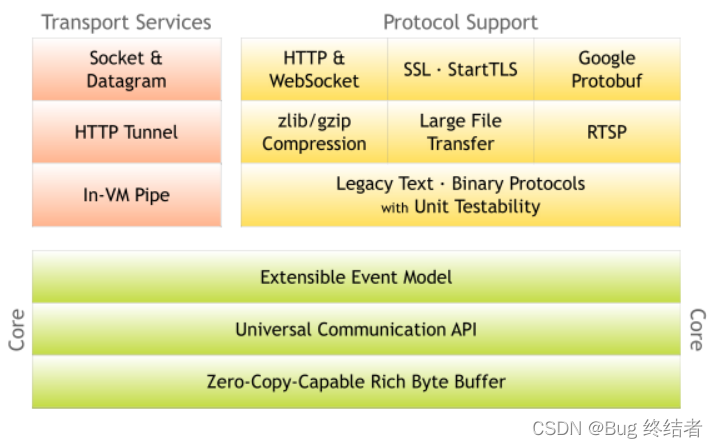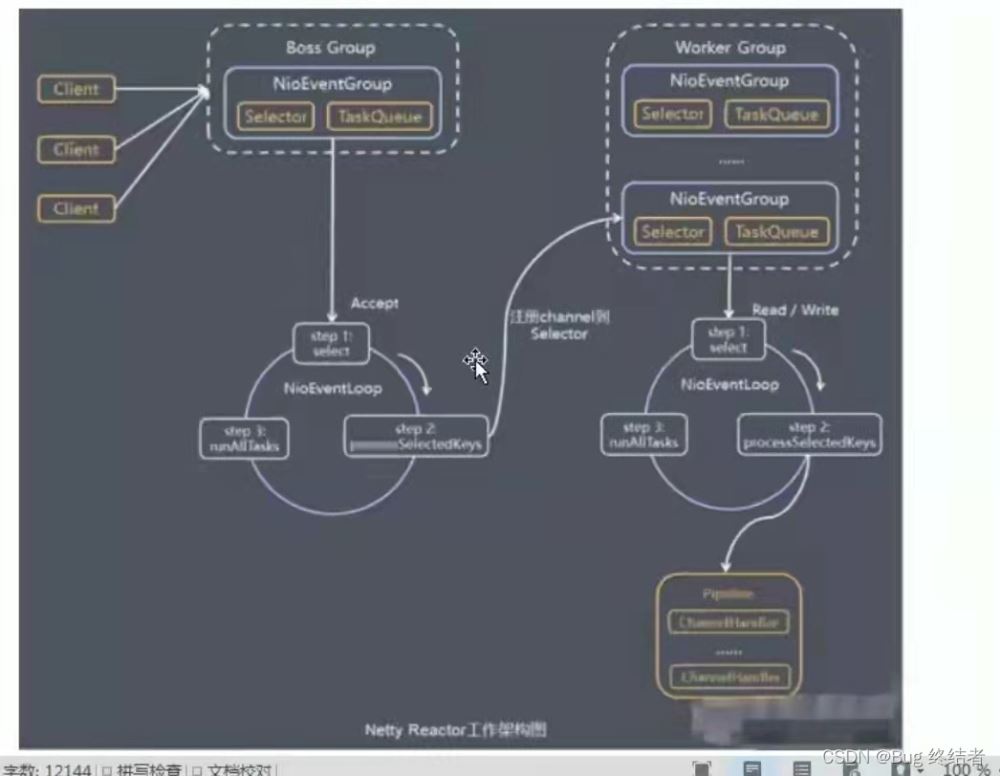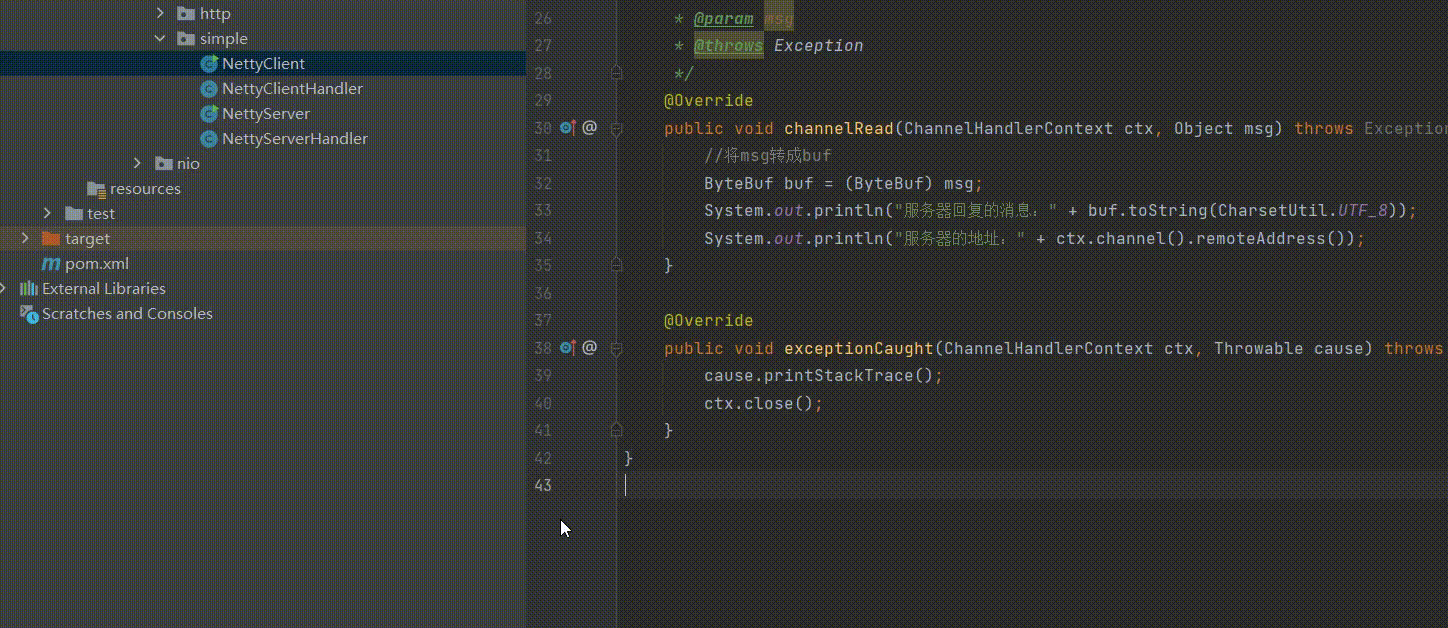学习Netty需要了解BIO、NIO、AIO,具体可参考
Java网络编程IO模型 — BIO、NIO、AIO详解
官网介绍
Netty is an asynchronous event-driven network application framework
for rapid development of maintainable high performance protocol servers & clients.
Netty 是 一个异步事件驱动的网络应用程序框架
,用于快速开发可维护的高性能协议服务器和客户端。
Netty 是一个 NIO 客户端服务器框架,可以快速轻松地开发协议服务器和客户端等网络应用程序。它极大地简化和流线了网络编程,例如 TCP 和 UDP 套接字服务器。
“快速和简单”并不意味着生成的应用程序会受到可维护性或性能问题的影响。Netty 是经过精心设计的,它借鉴了许多协议(如 FTP、SMTP、HTTP 以及各种基于二进制和基于文本的遗留协议)的实现经验。因此,Netty 成功地找到了一种方法,可以在不妥协的情况下实现易于开发、性能、稳定性和灵活性。
Netty在NIO的基础上进行了封装,比NIO强大,Netty使用很广泛,用的企业多,所以需要去学习,Netty支持高并发,在高并发的情况下具有良好的吞吐量,是网络通讯的首选框架
Netty对JDK自带的NIO的API进行了封装,解决了上述问题
Netty模型图

Netty在互联网领域、大数据分布式计算领域、游戏行业、通信行业等获得了广泛的应用,一些业界著名的开源组件也基于Netty的NIO框架构建 (文章尾有详细介绍)。 2.Netty的特点 高并发 Netty是一款基于NIO(Nonblocking IO,非阻塞 IO)开发的网络通信框架,对比于BIO(Blocking IO,阻塞IO),他的并发性能得到了很大提高 。
工作原理示意图-简单版
Netty主要基于主从Reactor多线程模型,做了一定的改进,其中主从Reactor多线程有多个Reactor

对上图说明
Netty主要基于主从Reactor多线程模型,做了一定的改进,其中主从Reactor多线程模型有多个Reactor


对上图的说明
7.每个Worker NIOEventLoop 循环执行的步骤
8.每个Worker NIoEventLoop 处理业务时,会使用pipeline(管道)pipeline中包含了channel,即通过了pipelien可以获取到对应通道,管道中维护了很多的处理器
Netty服务器在6666端口监听,客户端发送消息给服务器 “Hello,服务器”
服务器可以回复消息给客户端 “hello 客户端”

NettyServer
服务器,监听6666端口
package com.wanshi.netty.simple;
import io.netty.bootstrap.ServerBootstrap;
import io.netty.channel.*;
import io.netty.channel.nio.NioEventLoopGroup;
import io.netty.channel.socket.SocketChannel;
import io.netty.channel.socket.nio.NioServerSocketChannel;
public class NettyServer {
public static void main(String[] args) throws Exception {
// 创建BossGroup 和 WorkerGroup
//说明
//1.创建2个线程组,分别是boosGroup和workerGroup
//2.boosGroup只是处理连接请求,真正的与客户端业务处理,会交给workerGroup完成
//3.两个都是无限循环
//4. boosGroup 和 workerGroup 含有的子线程(NioEventLoop)的个数
// 默认实际 CPU核数*2
EventLoopGroup boosGroup = new NioEventLoopGroup();
EventLoopGroup workerGroup = new NioEventLoopGroup();
try {
//创建服务器端的启动的对象,配置参数
ServerBootstrap bootstrap = new ServerBootstrap();
//使用链式编程来进行设置
bootstrap.group(boosGroup, workerGroup) // 设置两个线程组
.channel(NioServerSocketChannel.class) //使用NioServerSocketChannel作为服务器的通道实现
.option(ChannelOption.SO_BACKLOG, 128) // 设置线程队列等待连接个数
.childOption(ChannelOption.SO_KEEPALIVE, true) // 设置保持活动连接状态
.childHandler(new ChannelInitializer<SocketChannel>() { // 创建一个通道初始化对象(匿名对象)
//给pipeline 设置处理器
@Override
protected void initChannel(SocketChannel socketChannel) throws Exception {
//可以使用一个集合管理SocketChannel,再推送消息时,可以将业务加入到各个channel对应的NioEventLoop的taskQueue
//或者 scheduleTaskQueue
System.out.println("客户 SocketChannel:" + socketChannel.hashCode());
socketChannel.pipeline().addLast(new NettyServerHandler());
}
}); //给我们的workerGroup的某一个EventLoop的对应的管道设置处理器
System.out.println("服务器 is ready...");
//绑定一个端口并且同步,生成了一个ChannelFuture对象
//启动服务器并绑定端口
ChannelFuture channelFuture = bootstrap.bind(6668).sync();
channelFuture.addListener(new ChannelFutureListener() {
@Override
public void operationComplete(ChannelFuture future) throws Exception {
if (channelFuture.isSuccess()) {
System.out.println("监听端口 6668 成功");
} else {
System.out.println("监听端口 6668 失败");
}
}
});
//对关闭通道进行监听
channelFuture.channel().closeFuture().sync();
} catch (Exception e) {
e.printStackTrace();
} finally {
//优雅关闭
boosGroup.shutdownGracefully();
workerGroup.shutdownGracefully();
}
}
}NettyServerHandler
服务器处理器,处理客户端发送的消息并输出到控制台,并向服务端发送消息
package com.wanshi.netty.simple;
import io.netty.buffer.ByteBuf;
import io.netty.buffer.Unpooled;
import io.netty.channel.ChannelHandlerContext;
import io.netty.channel.ChannelInboundHandlerAdapter;
import io.netty.util.CharsetUtil;
import java.util.concurrent.TimeUnit;
/**
* 自定义一个Handler,需要继承netty规定好的某个HandlerAdapter
* 这时我们自定义的handler才能称为一个handler
*/
public class NettyServerHandler extends ChannelInboundHandlerAdapter {
//读取数据事件(这里我们可以读取客户端发送的消息)
/**
* 1.ChannelHandlerContext ctx: 上下文对象,含有 管道pipeline,通道channel,地址
* 2.Object msg:就是客户端发送的数据,默认Object
* @param ctx
* @param msg
* @throws Exception
*/
@Override
public void channelRead(ChannelHandlerContext ctx, Object msg) throws Exception {
System.out.println("server ctx =" + ctx);
//将 msg 转成一个ByteBuf
// ByteBuf buf = (ByteBuf) msg;
// System.out.println("客户端发送消息是:" + buf.toString(CharsetUtil.UTF_8));
// System.out.println("客户端地址:" + ctx.channel().remoteAddress());
//自定义普通任务队列,将耗时长的任务加入队列,定义到NioEventLoop --> taskQueue
ctx.channel().eventLoop().execute(new Runnable() {
@Override
public void run() {
try {
Thread.currentThread().sleep(10 * 1000);
ctx.writeAndFlush(Unpooled.copiedBuffer("hello,客户端:喵2~", CharsetUtil.UTF_8));
} catch (InterruptedException e) {
e.printStackTrace();
}
}
});
Thread.currentThread().sleep(20 * 1000);
ctx.writeAndFlush(Unpooled.copiedBuffer("hello,客户端:喵3~", CharsetUtil.UTF_8));
//用户自定义定时任务 --》 该任务是提交到 scheduleQueue中
ctx.channel().eventLoop().schedule(new Runnable() {
Thread.currentThread().sleep(5 * 1000);
ctx.writeAndFlush(Unpooled.copiedBuffer("hello,客户端:喵4~", CharsetUtil.UTF_8));
}, 5, TimeUnit.SECONDS);
System.out.println("go ~");
}
* 数据读取完毕
public void channelReadComplete(ChannelHandlerContext ctx) throws Exception {
//writeAndFlush 是 write+flush
//将数据写入到缓存,并刷新
//一般讲,需要对发送的数据进行编码
ctx.writeAndFlush(Unpooled.copiedBuffer("hello,客户端:喵1~", CharsetUtil.UTF_8));
//处理异常,一般是需要关闭通道
public void exceptionCaught(ChannelHandlerContext ctx, Throwable cause) throws Exception {
ctx.close();
}NettyClient
客户端,用于连接服务器
package com.wanshi.netty.simple;
import io.netty.bootstrap.Bootstrap;
import io.netty.channel.ChannelFuture;
import io.netty.channel.ChannelInitializer;
import io.netty.channel.EventLoopGroup;
import io.netty.channel.nio.NioEventLoopGroup;
import io.netty.channel.socket.SocketChannel;
import io.netty.channel.socket.nio.NioSocketChannel;
public class NettyClient {
public static void main(String[] args) throws Exception {
//客户端需要一个事件循环组
EventLoopGroup eventExecutors = new NioEventLoopGroup();
try {
//创建一个客户端启动对象
//客户端使用的不是ServerGroup 而是Bootstrap
Bootstrap bootstrap = new Bootstrap();
//设置相关参数
bootstrap.group(eventExecutors) //设置线程组
.channel(NioSocketChannel.class) //设置客户端通道的实现类(反射)
.handler(new ChannelInitializer<SocketChannel>() {
@Override
protected void initChannel(SocketChannel socketChannel) throws Exception {
socketChannel.pipeline().addLast(new NettyClientHandler()); //加入自己的处理器
}
});
System.out.println("客户端 is ok...");
//启动客户端去连接服务器端, netty异步模型ChannelFuture
ChannelFuture channelFuture = bootstrap.connect("127.0.0.1", 6668).sync();
//给关闭通道进行监听
channelFuture.channel().closeFuture().sync();
} finally {
//优雅关闭线程池
eventExecutors.shutdownGracefully();
}
}
}NettyClientHandler
客户端处理器,处理服务器发送的消息输出到控制台,并向服务器发送消息
package com.wanshi.netty.simple;
import io.netty.buffer.ByteBuf;
import io.netty.buffer.Unpooled;
import io.netty.channel.ChannelHandlerContext;
import io.netty.channel.ChannelInboundHandlerAdapter;
import io.netty.util.CharsetUtil;
public class NettyClientHandler extends ChannelInboundHandlerAdapter {
/**
* 当通道就绪就会触发该方法
* @param ctx
* @throws Exception
*/
@Override
public void channelActive(ChannelHandlerContext ctx) throws Exception {
System.out.println("client " + ctx);
ctx.writeAndFlush(Unpooled.copiedBuffer("hello,服务端Server:喵~", CharsetUtil.UTF_8));
}
* 当通道有读取事件时,会触发
* @param msg
public void channelRead(ChannelHandlerContext ctx, Object msg) throws Exception {
//将msg转成buf
ByteBuf buf = (ByteBuf) msg;
System.out.println("服务器回复的消息:" + buf.toString(CharsetUtil.UTF_8));
System.out.println("服务器的地址:" + ctx.channel().remoteAddress());
// 当通道发生异常时执行此方法
public void exceptionCaught(ChannelHandlerContext ctx, Throwable cause) throws Exception {
cause.printStackTrace();
ctx.close();
}以上就是【Bug 终结者】对Netty入门简单的理解,小编认为Java中支持三种网络编程IO模型,BIO、NIO、AIO,Netty对NIO又做了一层封装,本文我们已大致了解Netty到底是什么,Netty入门案例还需多敲,多练,方可掌握,通过本文能加固你对Netty的理解